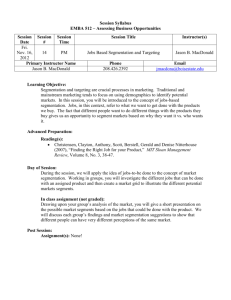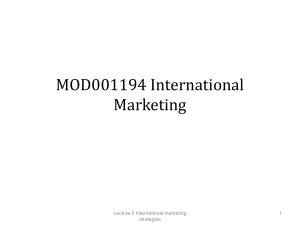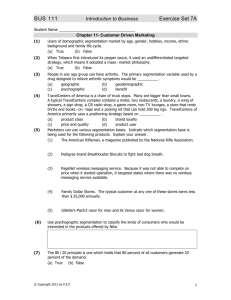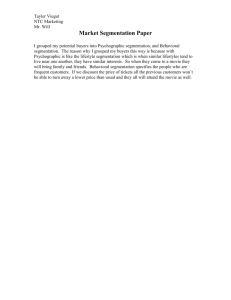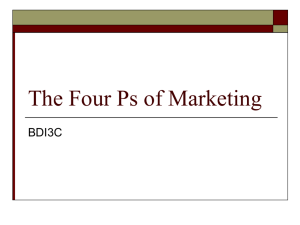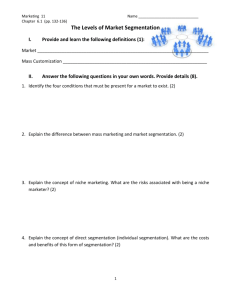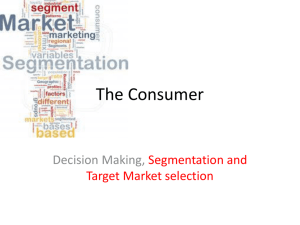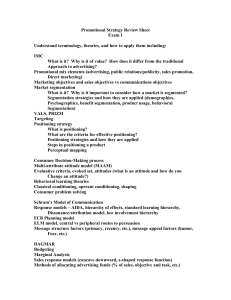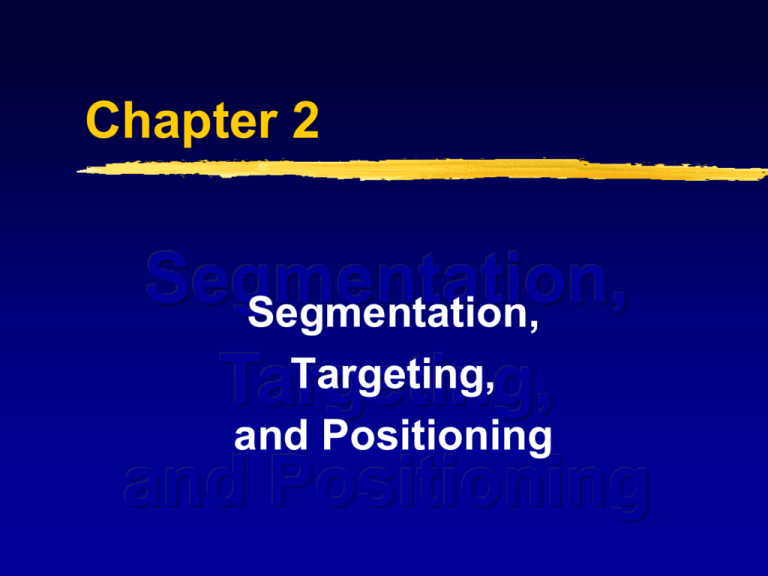
Chapter 2
Segmentation,
Segmentation,
Targeting,
Targeting,
and Positioning
and Positioning
Snapshot From the Marketplace
To succeed in today’s highly fragmented
marketplace, firms have to isolate key
market segments and reach these
segments with maximum possible impact.
Examples include innovative programs
such as Facebook’s “Instant
Personalization” and Kimberly-Clark’s
“parentstages.”
Mass-Marketing Strategy
Is a philosophy that presumes
consumers are uniform and that
broad-appeal products and marketing
programs suffice
Mass-Market Strategy (cont’d)
In 1908, Henry Ford’s mass-market strategy
involved using economies of scale to produce
the Model-T, a standardized, low-priced
automobile.
His basic assumption: Customers have
homogeneous preferences
Other examples of a mass-market strategy
include early Coca-Cola and the Bell Telephone
System
Ineffectiveness of Mass-Marketing
Consumers that comprise the marketplace
are heterogeneous, consisting mostly of
smaller niches of people, each with unique
demographic and lifestyle characteristics.
Consequently, marketers employ
strategies to match products to markets
via separate marketing mixes.
Segmentation Examples
http://www.pg.com/en_US/brands/all_brand
s.shtml
http://www.tide.com/enUS/productLanding.jspx
www.nissanusa.com
Q. 1. Define Marketing
Concept and Market
Orientation.
Marketing Concept
A market-focused, customer-oriented,
coordinated marketing effort aimed at
generating customer satisfaction as the key to
satisfying organizational needs.
Market Orientation
The organizational generation of market
intelligence pertaining to current and future
consumer needs, dissemination of that
intelligence across departments, and
organization-wide responsiveness to that
intelligence.
Q. 2. What are the various
components of the Market
Orientation?
Market Orientation
Customer Focus
Market Intelligence
Coordinated marketing
Environmental conditions
Degree of competitiveness in the industry
Q. 3. What are the three
major steps in segmenting
consumer markets?
Segmenting Consumer Markets:
The Product-Market Matching Strategy
The three components of the productmarket matching strategy are:
Market segmentation
Market targeting
Positioning
Product-Market Matching Strategy
Segmentation
Act of dissecting the marketplace into submarkets
that require different marketing mixes
Targeting
Process of reviewing market segments and deciding
which one(s) to pursue
Positioning
Establishing a differentiating image for a product or
service in relation to its competition
No Market Segmentation
Segmented by Sex
Segmented by Age
Q. 4. Define Market
Segmentation.
Segmentation
Segmentation
Act of dissecting the marketplace into submarkets
that require different marketing mixes
Q. 5. What are the four
basic segmentation
criteria?
I. Segmentation
Variables used to segment consumer
markets:
Geographic
Demographic
Psychographic
Behavioral
Geographic Segmentation
Partitions the market based on climate,
location, surroundings, and terrain
Example
Clothing, food, and automobile manufacturers,
as well as the media—including electronic, print,
and broadcast vehicles—often use geographic
segmentation to accommodate the specific
needs and interests of geographically dispersed
customers
Demographic Segmentation
Partitions the market based on factors
such as age, stage of the family life cycle,
gender, race and ethnicity, as well as
occupation
Demographic Segmentation (cont’d)
Age: A significant correlation exists
between consumption of certain
products/services and age (e.g., healthcare products/services, insurance, and
investments)
Stage of the family life cycle: Stages of
the FLC determine demand for housing,
furniture, appliances, children’s products
and services, as well as long-distance
phone services.
Demographic Segmentation (cont’d)
Gender: Important in the case of many
products/services such as cosmetics, perfumes,
clothing, and jewelry.
Race and ethnicity: Products/services targeted
along ethnic lines range from clothing and
cosmetics to foods and entertainment.
Occupation: A factor related to income,
education, and employment status. Occupational
breakdowns range from professional and
technical workers to unskilled labor.
Geodemographic Segmentation
Partitions the market by considering data on small
units of geography, such as neighborhoods, zip
codes, or census tracts
Examples:
PRIZM 66-cluster
ESRI Tapestry organized into 12 Life Mode and 11
Urbanization summary groups
Acxiom’s PersonicX household-level segmentation
system
Geodemographic Segmentation (cont’d)
How PRIZM is used:
PRIZM reveals to clients, such as BMW and
AOL, who their customers are and where they
reside by zip code, census tracts, and city
blocks.
It provides consumption indices (potential)
for a variety of product categories in various
market regions.
Psychographic Segmentation
Partitions the market based on lifestyle and
personality characteristics
Example
Psychographic segmentation
can be accomplished by
using AIO inventories—
questionnaires that
reveal consumers’
activities, interests,
and opinions
Behavioral Segmentation
Partitions the market based on attitudes
toward or reactions to a product and to its
promotional appeals
Examples: Behavioral segmentation can be
done on the basis of:
Usage rate or quantity usually purchased
Benefits sought from a product
Degree of loyalty to a brand or a store
Degree of sensitivity or responsiveness to
marketers’ promotional offers
II. Market Targeting
Once segmentation is complete, a portrait
of the market known as a market profile
emerges.
Market profile
A portrait of the various market
segments and competitors’ positions in
them relative to a specific product
Market Targeting (cont’d)
Marketing managers evaluate the various
segments in the market profile. They then
decide on how many and which one(s) to
pursue.
This targeting decision is dependent on a
firm’s financial resources as well as its
production and marketing capabilities.
Q. 6. What three
strategies are helpful in
serving target markets?
Types of Market-Targeting Strategies
Undifferentiated Strategy
The market is viewed as a single large homogeneous
domain where a single marketing mix suffices.
Multisegment Strategy
The market is viewed as two or more segments requiring
different marketing mixes.
Concentration Strategy
Focusing marketing effort on a single segment.
2-23
Choosing Market Segments to Target
Undifferentiated Segmentation
Differentiated Segmentation or
Multi-Segment Marketing
Concentrated Segmentation
or Niche Marketing
Targeting Considerations
Criteria a firm must consider before selecting
market segment(s):
Size
Measurability
Compatibility
Defendability
Potential
Accessibility
Stability
Q. 7. Define Positioning.
III. Positioning
Deciding how the organization wants the company
and its brands to be perceived and evaluated by
target markets.
Once marketers have segmented the market and
selected the target, the product offering needs to be
properly positioned.
A product’s position is the manner in which a
product is perceived by consumers as compared to
their perception of competitors’ offerings.
Positioning (cont’d)
The decision concerning the price to
charge for the product/service, the
promotional activities to employ, and the
type of distribution channel selected to
deliver the item to consumers, all affect
the positioning of a brand in the
marketplace.
Clothing Stores
Target
Wal-Mart
Saks Fifth Avenue
Kohl’s
Dollar General
Dillard's
Sears
Family Dollar
Nordstrom
Neiman Marcus
JC Penney
Copyright © 2012
by South Western,
a division of
Cengage
Learning. All rights
reserved.
Selecting a Unique Selling Proposition
A successful positioning strategy for many
firms rests on the selection of a single
benefit to emphasize in promotional
messages for the brand.
Creating a brand personality is one of the
primary goals of positioning.
Repositioning
Repositioning can take one or more of the
following forms:
Modifying an existing brand
Targeting it to a new market segment
Emphasizing new product uses and benefits
Stressing different features with the intention
of boosting sales

